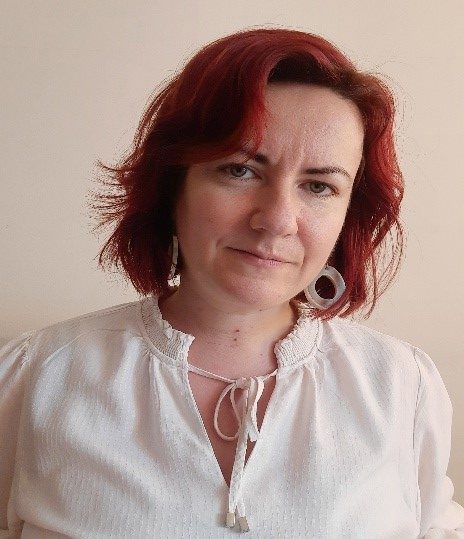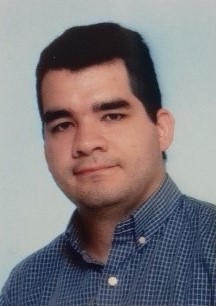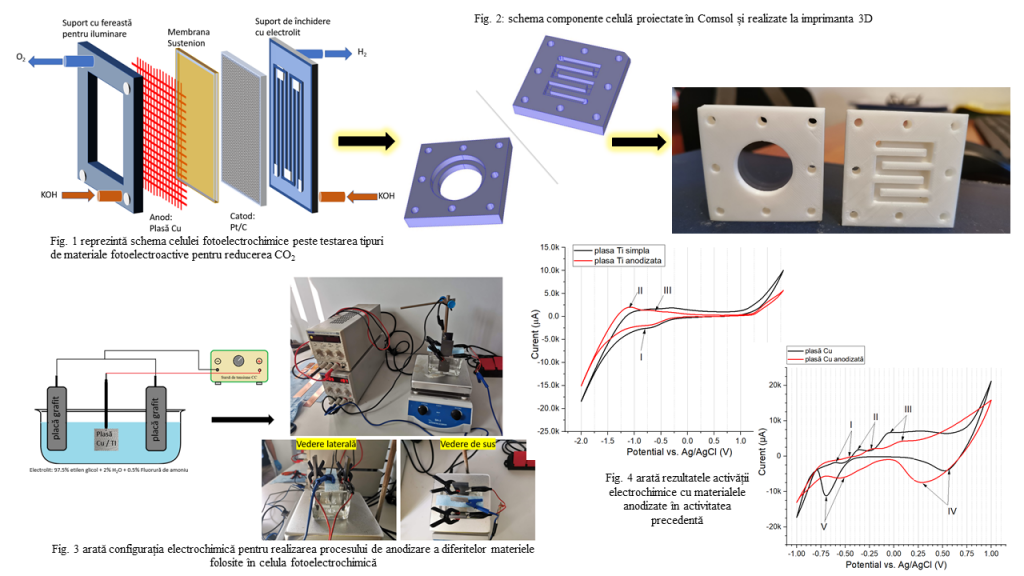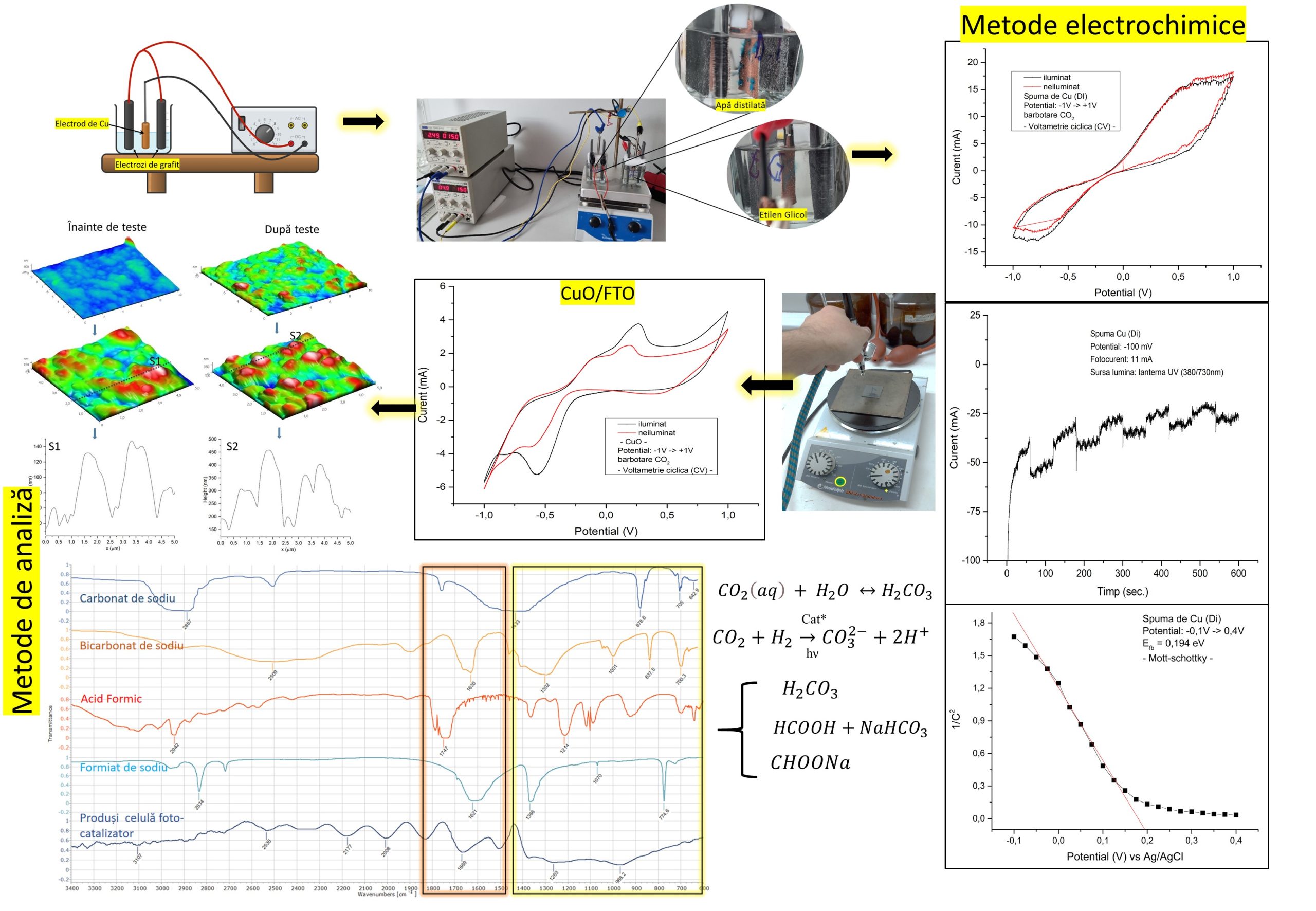- Project Acronym: CuCO2RR
- Contract: 134/ 2017
- Contracting Autority: UEFISCDI
- Contractor: Universitatea din Bucuresti
- Allocated Funds: 431.900,00 lei
Project leader:
 Dr. Adriana Balan, Lector/CSIII, Facultatea de Fizică, Universitatea din București, titlul de Doctor în Fizică obținut în anul 2011. Este co-fondator al Centrului de Cercetare 3Nano-SAE și coordonează activitatea de cercetare a studenților în cadrul programului de master Surse de Energii Regenerabile și Alternative, în cadrul Facultății de Fizică. Experiență profesională în activitatea de cercetare: materiale compozite polimerice, carbonice cu aplicații în dispozitive electrochimice- pile de combustie, metode de caracterizare materiale- microscopie de forțe atomice, analize termice, electrochimie. Participă în implementare proiectului internațional ”Metode inovative de învățare pentru viitorii specialiști în energii regenerabile” care are ca obiectiv crearea unei platforme educaționale între Universitatea Reykjavik și Universitatea din București și mobilități inter-universitare în vederea formării viitorilor specialiștilor în energie regenerabilă. A fost director sau responsabil de proiect în cinci proiecte de cercetare naționale și a participat în 15 proiecte ca membru în echipă. Este co-autor a patru brevete naționale, a publicat 57 de lucrări ISI, cu peste 500 de citări, indice Hirsh 13 (http://www.researcherid.com/rid/B-7331-2011).
Dr. Adriana Balan, Lector/CSIII, Facultatea de Fizică, Universitatea din București, titlul de Doctor în Fizică obținut în anul 2011. Este co-fondator al Centrului de Cercetare 3Nano-SAE și coordonează activitatea de cercetare a studenților în cadrul programului de master Surse de Energii Regenerabile și Alternative, în cadrul Facultății de Fizică. Experiență profesională în activitatea de cercetare: materiale compozite polimerice, carbonice cu aplicații în dispozitive electrochimice- pile de combustie, metode de caracterizare materiale- microscopie de forțe atomice, analize termice, electrochimie. Participă în implementare proiectului internațional ”Metode inovative de învățare pentru viitorii specialiști în energii regenerabile” care are ca obiectiv crearea unei platforme educaționale între Universitatea Reykjavik și Universitatea din București și mobilități inter-universitare în vederea formării viitorilor specialiștilor în energie regenerabilă. A fost director sau responsabil de proiect în cinci proiecte de cercetare naționale și a participat în 15 proiecte ca membru în echipă. Este co-autor a patru brevete naționale, a publicat 57 de lucrări ISI, cu peste 500 de citări, indice Hirsh 13 (http://www.researcherid.com/rid/B-7331-2011).
Team Members:
 Cornelia Diac, age: 28, PhD in Physics (2017-2021). Over the Ph.D program I accumulated a rich experience in managing and conducting project activities, being able to undergo research topics of great complexity in the field of electrochemistry and dissolution processes. I gained significant knowledge in electrochemical processes and I learned how to operate a large group of devices, from which relevant to this project: Electrochemical potentiostat/galvanostat, ICP – OES, Raman, UV – Vis Spectroscopy, CHNS Elemental Analyzer, Thermogravimetric analyzer.
Cornelia Diac, age: 28, PhD in Physics (2017-2021). Over the Ph.D program I accumulated a rich experience in managing and conducting project activities, being able to undergo research topics of great complexity in the field of electrochemistry and dissolution processes. I gained significant knowledge in electrochemical processes and I learned how to operate a large group of devices, from which relevant to this project: Electrochemical potentiostat/galvanostat, ICP – OES, Raman, UV – Vis Spectroscopy, CHNS Elemental Analyzer, Thermogravimetric analyzer.
 Drd. Tom Iacob is a PhD student at the Faculty of Physics of the University of Bucharest were he studies the possibility of CO2 reduction with the help of microorganisms, he holds a MSc from the Faculty of Physics with the thesis title: Bioelectrochemical systems. Elaboration of a working method for redox potential determination of bacteria culture. He worked for more than two years at the Institute of Biology of Romanian Academy at Microbiology department and has experience in monitoring bacteria in bioelectrochemical systems and microbial fuel cells. He also has knowledge in working with UV-vis spectrometers, potentiostats, ICP-oes and Plasma RF generator.
Drd. Tom Iacob is a PhD student at the Faculty of Physics of the University of Bucharest were he studies the possibility of CO2 reduction with the help of microorganisms, he holds a MSc from the Faculty of Physics with the thesis title: Bioelectrochemical systems. Elaboration of a working method for redox potential determination of bacteria culture. He worked for more than two years at the Institute of Biology of Romanian Academy at Microbiology department and has experience in monitoring bacteria in bioelectrochemical systems and microbial fuel cells. He also has knowledge in working with UV-vis spectrometers, potentiostats, ICP-oes and Plasma RF generator.
Drd. Bogdan Ciprian Mitrea has been interested in fuel cell technology since his undergraduate studies at the University of Bucharest’s Faculty of Physics. He earned a degree in physics with a thesis on “Determining the Efficiency of Fuel Cells” and went on to earn a master’s degree in “Assembly and Testing of g-C3N4 Photoelectrodes”. He is now working to increase the efficiency of photocatalysts in redox reactions in order to explore CO2 reduction processes using photoelectrochemical cells. Additionally, he is researching possible uses for nanoparticles in plant growth and development. Bogdan gained expertise in the use of electrochemical potentiostats, optical microscopy, UV-visible spectroscopy, semiconductor treatment in O2 plasma, polymerization in direct current plasma (DC), and thin film deposition by magnetron sputtering.
Dr. Ioan Stamatin, Professor Ph.D, at the Faculty of Physics, University of Bucharest (FF-UB). Areas of expertise: Electrochemical energy converters (Fuel cells, batteries, supercapacitors); Eco-nanotechnologies; Nanomaterials Synthesis; Polymers, biopolymers, bio-nanotechnologies; Rapid Prototyping and energy storage applications (supercapacitors, batteries, sensors); Electrocatalysts based platinum used in fuel cells; Sensors and electrochemical method for different analyte detections; Physico–chemical characterization of materials by spectroscopy (UV-Vis, FT-IR ATR, fluorescence); optical microscopy; ultrasound treatments. He is the founder and leader of 3NanoSAE Research Center, and his main expertise is in material science and characterization. He published 155 scientific papers; Patents indexed in Derwent international data base: 14; He supervised and refereed 28 PhD thesis; Project Leader in 7 projects, and as team member in other 20 research projects; > 1700 citations. , h-index 24 (ISI Web of Science). Personal link: https://www.brainmap.ro/ioan-stamatin
Indicators:
– min 2 scientific papers published in ISI indexed journals,
– 2 conference / poster papers
– 1 patent application based on the knowledge gained during the implementation of the project
Phase I Design and construction of the test bench. Synthesis of nanostructured materials. (Deadline 31.12.2021)
During Phase I / 2021, several Cu based structures were tested and characterized using a new photoelectrochemical cell configuration. The obtained materials were characterized from a morpho-structural and physico-chemical point of view using the following methods: atomic force microscopy (AFM), scanning electron microscopy (SEM), UV-Viz and Raman spectrophotometry, electrochemical measurements (cyclic voltammetry, spectroscopy electrochemical impedance). The results obtained demonstrate the potential of these catalysts based on Cu nanostructures for the electrochemical reduction of CO2. In the next stage, studies will be continued to obtain various Cu-based nanostructures through plasma activation processes and optimize the CO2 conversion process.

Phase II. Study of the fotoelectrochemical CO2 reduction reaction- I (Deadline 31.12.2022)
The synthesis process of the photo-electrocatalyst by anodization was optimized, resulting in a consistent protocol for obtaining the catalyst. A CNC system has also been developed for treating the photocatalyst in an open atmosphere plasma jet. The resulting samples were investigated morphologically by atomic force microscopy. Then, the photo-electrochemical processes of CO2 reduction by copper-based catalysts were studied, by specific electrochemical methods (chronoamperometry and cyclic voltammetry). The products in the photo-electrocatalysis process were analyzed through FT-IR spectrometry and the presence of the sodium formate compound was highlighted as a result of the reaction between the formic acid (produced in the CO2 reduction process) and the carbonate of sodium (from the electrolyte solution). The catalyst layers were morphologically analyzed before and after performing the photoelectrocatalysis tests, to determine the average roughness.

Phase III. Study of the fotoelectrochemical CO2 reduction reaction- II (Deadline 31.05.2023)
The protocol for treatment in O2 plasma was optimized, based on which a Cu nanostructured photocatalyst was synthesized. The next step was to characterize it in terms of photo/electrochemical (Chronoamperometry, Cyclic Voltammetry and Mott-Schottky) and morphological (SEM) properties. By means of qualitative and quantitative techniques, FTIR spectroscopy and titration method, the presence and quantity of the reaction product (HCOOH) obtained from the CO2 reduction process was determined. Quantum efficiency (photon to electron conversion efficiency) and Faradaic efficiency were also evaluated. The results obtained in this step have been disseminated as follows: 3 oral presentations at national conferences and 1 patent application registered at OSIM.
Publication list
(1) Ionescu, V.; Balan, A.E.; Trefilov, A.M.I.; Stamatin, I. Exergetic Performance of a PEM Fuel Cell with Laser-Induced Graphene as the Microporous Layer. Energies 2021, 14, 6232. https://doi.org/10.3390/en14196232
(2) Trefilov, A.M.I.; Balan, A.; Stamatin, I. Hybrid Proton-Exchange Membrane Based on Perfluorosulfonated Polymers and Resorcinol–Formaldehyde Hydrogel. Polymers 2021, 13, 4123. https://doi.org/10.3390/polym13234123
(3) Balan Adriana Elena, Bogdan Ionut Bita, Sorin Vizireanu, Gheorghe Dinescu, Ioan Stamatin, and Alexandra Maria Isabel Trefilov. 2022. “Carbon-Nanowall Microporous Layers for Proton Exchange Membrane Fuel Cell” Membranes 12, no. 11: 1064. https://doi.org/10.3390/membranes12111064
Patents
Nanostructuri electrocatalitice pe bază de oxid de cupru pentru electroreducerea CO2 și procedeu de obținere a acestora, Ioan STAMATIN, Bogdan MITREA, Tom IACOB, Șerban STAMATIN, Cornelia, NICHITA, cerere de brevet înregistrată la OSIM, nr. A/00268/ 29.05.2023
Conferences
- Copper and TiO2 Nanoparticles Effects Over The Photosynthesis Process in Plants, Bogdan Ciprian MITREA, Cornelia NICHITA, Cornelia DIAC, Tom Matei IACOB, Bogdan DOBRICĂ, Adriana BĂLAN, Ioan STAMATIN, 20th International Balkan Workshop on Applied Physics (Poster), 12-15 iuli 2022.
- STUDY ON THE INFLUENCE OF IONIC MEMBRANE TYPE IN A CO2 ELECTROLYZER, Bogdan Ciprian MITREA, Cornelia NICHITA, Cornelia DIAC, Tom Matei IACOB, Adriana BĂLAN, Ioan STAMATIN, Jalali LAVASANI, 18th International Conference of Young Scientists on Energy and Natural Sciences Issues (Poster), 24-27 mai 2022.
- Nitrogen-doped Carbon Nanowalls as Microporous Layers in PEM Fuel Cells, Alexandra TREFILOV, Bogdan BIȚĂ, Sorin VIZIREANU, Adriana BĂLAN, Gheorghe DINESCU, EMRS Spring Meeting 2022, 30 mai – 3 iunie 2022 (Poster).
- N-doped Carbon Nanowalls as microporous layers in PEM Fuel Cell, Alexandra TREFILOV, Bogdan BIȚĂ, Sorin VIZIREANU, Adriana BĂLAN, Gheorghe DINESCU, International Conference on Laser, Plasma and Radiation – Science and Technology – ICPLR-ST (Poster), 7 – 10 iunie 2022.
- Plasma Functionalized Carbon Nanowalls as Microporous Layers in PEM Fuel Cells, Alexandra TREFILOV, Bogdan BIȚĂ, Sorin VIZIREANU, Ana FILIP, Marius DINCĂ, Bogdan SAVA, Gheorghe DINESCU, Andreea MATEI, Adriana BĂLAN, EMRS Fall Meeting 2021, September 20 – 23, 2021 (Prezentare Orală).
- Plasma Functionalized Carbon Nanowalls as Microporous Layers in PEM Fuel Cells, Alexandra TREFILOV, Bogdan BIȚĂ, Adriana BĂLAN, Sorin VIZIREANU, Gheorghe DINESCU 19th International Conference on Plasma Physics and Applications- Book of Abstracts:, August 31-September 3, 2021 (poster).
- The Influence of Cu and TiO2 Nanoparticles on Plants Photosynthesis Process, Bogdan Ciprian MITREA, Cornelia NICHITA, Cornelia DIAC, Tom Matei IACOB, Bogdan DOBRICĂ, Adriana BĂLAN, Ioan STAMATIN 2022 Annual Scientific Conference, (Prezentare Orală), 24 iunie 2022
- Bio-construction of electro-active layers, Matei-Tom IACOB, Cornelia DIAC, Bogdan Ciprian MITREA, Adriana BĂLAN, Ioan STAMATIN, 2022 Annual Scientific Conference (Prezentare Orală), 24 iunie 2022
- A more environmentally friendly method of recovering precious metals from printed circuit boards, Răzvan BALICA, Cornelia DIAC, Matei-Tom IACOB, Bogdan Ciprian MITREA, Adriana BĂLAN, Ioan STAMATIN, 2022 Annual Scientific Conference (Prezentare Orală), 24 iunie 2022
- Photosensitivity activation of copper foam by cold plasma treatment, Matei-Tom IACOB, Cornelia DIAC, Bogdan Ciprian MITREA, Adriana BĂLAN, Ioan STAMATIN, 2023 Annual Scientific Conference (Prezentare Orală), 26 mai 2023â
- Cu Nanoparticles Influence on Polyphenol Content in Ocimum Basilicum Plants, Bogdan Ciprian MITREA, Cornelia NICHITA, Cornelia DIAC, Tom Matei IACOB, Adriana BĂLAN, Ioan STAMATIN, 2023 Annual Scientific Conference (Prezentare Orală), 26 mai 2023
- Gold Dissolution In Electrochemical Systems: Exploring Eco-Friendly Methods For Sustainable Applications, Cornelia DIAC, Matei-Tom IACOB, Bogdan Ciprian MITREA, Adriana BĂLAN, Ioan STAMATIN, Șerban STAMATIN 2023 Annual Scientific Conference (Prezentare Orală), 26 mai 2023